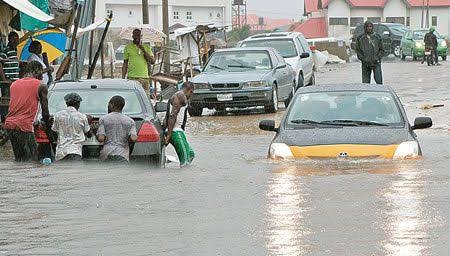
Pius Nsabe
The Federal Government has issued a nationwide flood alert, forecasting heavy rainfall over a five-day period from August 5 to 9, 2025. This rainfall is expected to trigger flooding in 76 locations across 19 states. The warning, released by the National Flood Early Warning Systems Centre under the Federal Ministry of Environment, urges residents and local authorities in affected areas to take urgent precautionary measures. The alert comes as fresh floods hit parts of Ogun and Gombe states, causing widespread disruption.
States at risk include Akwa Ibom, Bauchi, Ebonyi, Cross River, Nasarawa, Benue, Kaduna, Katsina, Kebbi, Kano, Niger, Plateau, Taraba, Jigawa, Yobe, Zamfara, Sokoto, Borno, and Gombe. The Federal Government’s forecast follows a string of devastating flooding incidents across the country. In 2025 alone, no fewer than 191 people have died, while 94 are still missing, according to data released by the National Emergency Management Agency. Niger State reported the highest number of fatalities with 163 deaths, followed by Adamawa with 26. At least 134,435 people have been affected in 20 states and 47 local government areas. The data also indicates that 239 people sustained injuries, 48,056 have been displaced, and 9,499 houses alongside 9,450 farmlands have been damaged. Women, children, the elderly, and persons with disabilities make up the majority of those impacted.
In Ogun State, flooding overwhelmed parts of Redemption City along the Lagos-Ibadan Expressway in Mowe. Residents, schoolchildren, and RCCG convention attendees were trapped for hours. Vehicles were submerged in areas like Estate 15, prompting the Redeemed Christian Church of God to deploy buses to rescue stranded worshippers. In Gombe State, four people died and 278 households were affected in multiple local government areas due to flooding and windstorms.
In Lagos, a night of torrential rain turned major roads and streets into rivers, crippling movement across both the mainland and island. Areas such as Ijede, Lekki, Surulere, Agege, Ajegunle, Alimosho, and Eti-Osa were submerged. Viral videos showed residents wading through waist-deep water, with many calling for immediate government action. Markets were disrupted, and transportation systems came to a standstill. Many blamed poor urban planning and blocked drainage systems for the annual catastrophe.

Delta State was not spared. Communities in Sapele and Oko experienced rising waters, forcing some residents to relocate. The state government has responded by setting up six internally displaced persons (IDP) camps equipped with basic amenities. Delta’s Commissioner for Environment, Mr. Jamani Ejiro, said the facilities were strategically located in Kwale, Ozoro, Patani, Bomadi, Uto-Jeremi, and Asaba. The government has also formed a Flood Disaster Management Committee, led by the Secretary to the State Government, to coordinate relief efforts and sensitise residents.
In Diggi town, Bunza Local Government Area of Kebbi State, a three-hour downpour submerged homes and displaced several residents. The state government has mobilised emergency aid, while community leaders have called for drainage maintenance and NGO support. Bauchi State’s Bagel community in Dass Local Government Area also suffered severe flooding, with at least 13 homes destroyed. Plateau State’s Shimankar District in Shendam Local Government Area witnessed a violent rainstorm that damaged over 50 houses, two schools, and a place of worship. Victims in Menkaat community said they lost nearly everything and were yet to receive emergency assistance.
In Imo State, 27 villages in Oguta Local Government Area and seven villages in Ohaji/Egbema were submerged. Flash floods also hit parts of Owerri West, including Oforola, Avu, New Owerri, and the Akachi area. In Rivers State, persistent rains triggered flash floods in Port Harcourt and Obio/Akpor. Flooded roads such as Amaechi Drive, Odili Road, and Rumuigbo became impassable. Environmental activist Dr. Fyneface Dumnamene urged the government to declare a state of emergency and prioritise drainage clearing and community sensitisation.
In Katsina State, authorities have designated public schools in Daura, Jibia, Funtua, and Bakori as temporary shelters. Emergency response committees have been activated in all 34 local government areas, and awareness campaigns are underway to prevent loss of life. Meanwhile, Bayelsa State has so far avoided major flooding in Yenagoa due to ongoing desilting projects and drainage improvements. Officials credited reconstruction works along Osiri Road and proactive measures by the Flood and Erosion Control Directorate for this success.
The Sokoto State Emergency Management Agency, in collaboration with NEMA, is conducting damage assessments in the worst-hit areas. In Yabo, Shagari, and Tureta LGAs, floods displaced hundreds, submerged farmlands, and destroyed homes. In Yabo, entire communities such as Shiyar Hegin-Rafi and Shiyar Ubandawaki were overwhelmed. In Tureta, floods injured two women and destroyed dozens of homes, including that of a Federal Road Safety Corps official. Authorities are now setting up temporary shelters and planning long-term mitigation.

Elsewhere, states such as Kano, Nasarawa, Kaduna, Benue, and Edo have not yet reported significant flooding but remain on high alert. Government agencies in these states have launched sensitisation campaigns and prepared evacuation centres in anticipation of possible disaster. Despite Kano being downstream of three major dams, no significant flooding has been recorded. However, officials have urged residents in vulnerable communities to remain vigilant.
In a bid to support the nationwide flood response, the National Economic Council recently approved financial disbursements, including ₦3 billion to each state and the FCT, ₦10 billion to NEMA, and ₦1.5 billion each to key federal ministries involved in planning, environment, and water resources.
While these interventions provide some relief, experts warn that unless Nigeria invests in long-term infrastructure, flood mapping, and public education, seasonal flooding will continue to claim lives and destroy livelihoods every year.
